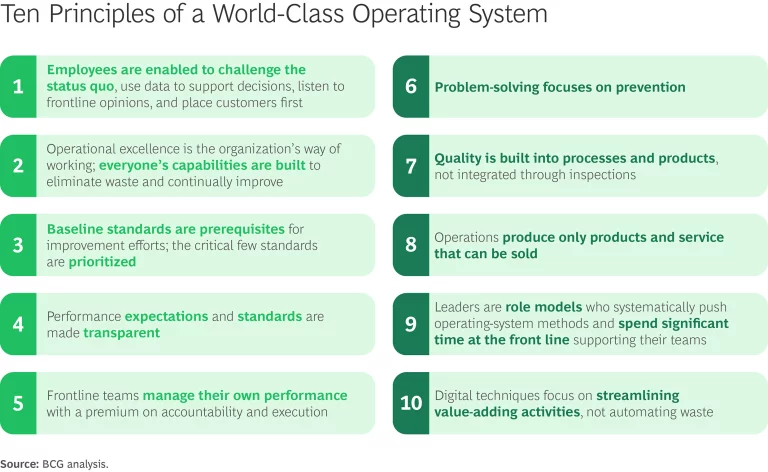Operational transformations in manufacturing frequently begin with bold intentions, ambitious strategies, and advanced digital tools. These efforts seek step change improvements in processes and systems, yet many fall short of their full potential. The reason is rarely flawed supporting tools but rather an insufficient emphasis on the human side of change. Leaders often devote disproportionate attention to the technical aspects while underestimating the critical role of shifting mindsets and behaviors, including their own.
Consider a hypothetical example: a logistics company invested millions in automating warehouse operations and deploying advanced analytics. Despite these efforts, on-time delivery performance stagnated and employee engagement diminished. The root cause? A lack of leadership visibility and communication about the transformation’s purpose. Workers felt alienated by rapid changes they didn’t understand, and leaders underestimated the need to evolve their own roles and behaviors. The absence of shared ownership and behavioral alignment undermined the potential of otherwise strong technical investments.
Achieving transformational success in the face of such challenges demands a convergence of leadership and frontline teams around six behavioral shifts that foster greater buy-in and close the gap between ambitions and results.
Position Digitization as an Enabler, Not an Objective
Leaders must articulate why transformation is necessary in straightforward language to galvanize employee support. Incremental improvements, such as minor financial gains over previous years, fail to inspire. Instead, transformational goals should reflect strategic imperatives, such as gaining market share or achieving net zero emissions. These objectives should stretch the organization’s capabilities and transcend short-term performance horizons, without appearing unattainable.
It is equally valuable not to burden the organization with too many simultaneous initiatives or confuse strategic methods with end goals. Critically, while digitization can be a powerful enabler, it is a means to an end—not the transformation objective itself.
For example, a pharmaceutical company structured its transformation efforts around compelling business needs and foundational enablers. The compelling business needs defined the “what” (the strategic imperatives driving change), while the foundational enablers defined the “how” (the mechanisms promoting faster and more effective delivery). Digital initiatives were categorized as enablers, not business needs. These efforts helped streamline execution and enhance team engagement—such as through digital team boards that improved visibility and collaboration—rather than being the goal of the transformation.
Importantly, organizations should reserve the term “transformation” for initiatives that genuinely elevate performance to a new, sustainable standard. Such efforts are generally grounded in fundamental shifts in underlying beliefs, behaviors, capabilities, systems, and processes. Overuse of “transformation” dilutes the word’s significance and risks diverting resources from high-priority change efforts.
Stay ahead with BCG insights on manufacturing
Build a World-Class Operating System to Guide Actions
Sustained high performance in top organizations is rarely accidental. It typically stems from a deliberately designed operating system that endures beyond any individual leader or team. Exemplified by Toyota, such systems weave together philosophy, principles, goals, rules, practices, and tools into a coherent framework that guides everyone’s actions.
The foundational principles of effective operating systems are straightforward and center on positioning operations as the heart of the business. (See the exhibit.) Of course, this doesn’t happen in isolation. These principles must be applied collectively to align efforts and unlock frontline potential.

Moreover, great operating systems are dynamic, encouraging experimentation and embedding continuous improvement. They are codified, serve as reference standards, and evolve with each new insight. For instance, companies are learning how to focus their applications of AI to streamline value-adding processes rather than digitizing wasteful steps like redundant movements.
Organizations benefit by learning directly from companies that achieve high performance across business cycles. Visiting world-class operations and speaking with the architects of successful transformations can provide valuable insights. Leaders should seek to understand the hard and soft aspects of the transformation, the system used to deliver it, and the behavioral changes required. It often pays to find an external coach who can help build the leadership’s capabilities and enrich its understanding of transformation systems.
For example, the leadership team of a global health care firm visited a top automotive OEM. Inspired by what they observed, team members streamlined governance and redefined priorities. They outlined their own operation’s compelling business needs, culled meetings accordingly, and reduced the number of initiatives and reports needed to manage operations. These actions decreased their time spent in meetings by 30%, freeing up 140 leadership hours each month—nearly the capacity of an additional full-time leader. This allowed the team to devote more time to higher-value activities, such as effective problem-solving, frontline coaching, and continuous improvement.
Clarify and Elevate Leaders’ Roles in Driving Change
In high-performing organizations, leadership roles often diverge from traditional expectations. Leaders are expected to embody the operating system’s guiding principles and rigorously apply them in their day-to-day actions. For example, some top companies encourage everyone to challenge the status quo, a behavior that might be deemed undesirable elsewhere. Tools such as visual-performance management help leaders bring clarity to business priorities, expose problems, and foster improvements at all levels of the organization.
Leaders are expected to embody the operating system’s guiding principles and rigorously apply them in their day-to-day actions.
Digitization plays a key role here. Performance management is a natural candidate for digital enhancement because much of the relevant data already resides in existing digital systems. Leaders use this data not just to measure outcomes but to engage more deeply with frontline teams. By spending meaningful time on the shop floor, they verify whether teams understand and follow the operating system, provide coaching where needed, and incorporate learning back into the system.
Reducing organizational overload is critical to the effort. Effective leaders streamline governance structures, pare down redundant KPIs and reporting requirements, and limit the volume of simultaneous initiatives. This creates the headspace for middle managers and frontline teams to focus on delivering value and engaging in continuous improvement.
Clear role delineation between business leaders and change agents is essential. Business and line leaders remain ultimately accountable for system performance and results. Their responsibilities include setting goals, allocating resources, aligning incentives, managing performance, coaching teams, and engaging actively at the front line. Change agents, meanwhile, serve a vital supporting role: piloting the system, codifying best practices, building capabilities, and facilitating knowledge sharing. But they do so without supplanting the accountability of business leadership. This role delineation ensures that ownership and expertise are appropriately distributed and sustainable change can take root.
Sequence and Execute the Journey for End-to-End Impact
Leaders should break the transformation journey into manageable segments that the organization can absorb and execute effectively. Operating-system pilots should be concentrated in areas of high impact while accounting for upstream and downstream interdependencies. This ensures that improvements flow throughout operations and do not inadvertently result in blockages, such as increased inventory, elsewhere in the value chain. Early pilots should stabilize before the company focuses on the next segment of the journey.
Execution must adhere closely to the operating system’s principles, with tools deployed in a way that integrates them seamlessly and reinforces business goals. For example, visual-performance management can be used to identify improvement priorities, while standard work can help institutionalize those improvements. The tools should be implemented as a system rather than in isolation so that their effects reinforce one another.
We often see operations leaders advocate for the use of asset productivity metrics, like overall equipment effectiveness, without connecting them back to strategic objectives and customer demand. A better approach is to explicitly link such metrics to tangible business outcomes, such as increased throughput, cost reduction, or working-capital optimization. Without that connection, performance gains risk becoming disconnected from what actually matters to the organization.
Finally, effective transformation must address the entire end-to-end flow of products and services, from suppliers through to customers. This includes a deliberate effort to eliminate bottlenecks and address flow constraints across the value stream, step by step.
Activate Change Through Digitally Enabled Leadership
The longevity of any transformation ultimately depends on the collective behavior of the people in the organization. Successful transformations often include planned transitions to new leadership behaviors, such as a greater frontline presence, a stronger focus on prevention rather than reaction, or more peer-to-peer coaching for capability building.
The longevity of any transformation ultimately depends on the collective behavior of the people in the organization.
Leaders must not only support new behaviors but consistently role-model them in their own routines. Digital analytics and AI provide a powerful means to support this effort by making behavior-related metrics transparent and actionable, thereby reinforcing accountability and cultural alignment.
Senior leaders’ visible endorsement of new behavioral expectations—and their willingness to hold themselves to those standards—signals genuine commitment. Change becomes credible only when those at the top clearly communicate the purpose behind behavioral shifts and embody the new norms themselves.
In one example, an automotive supplier undertook a cultural shift from command-and-control to broad-based empowerment. The company defined specific behavioral expectations at the plant leadership and supervisor levels and embedded them into standard leadership routines. By codifying these practices into leaders’ schedules and operating rhythms, the company ensured that the new ways of working became part of daily life and not just an aspirational vision.
Ensure That Functions Promote the System’s Objectives
Every function within an organization—whether directly involved in operations or in supporting roles—plays a crucial part in enabling the operating system. This includes core operational areas like operations, maintenance, quality, planning, and logistics, as well as supporting functions such as HR, finance, procurement, and IT.
Take HR, for example. Talent acquisition and development must be tailored to ensure that employees have the skills and mindsets necessary to learn, apply, and improve the operating system. Incentive systems should reward adherence to and continuous improvement of the operating system.
Moreover, each function should leverage opportunities to implement useful elements of the operating system. Ultimately, world-class operating systems impact every function and every individual.
Leaders are the linchpins of successful transformations. While most operational-improvement concepts are relatively simple, integrating improvement tools into a cohesive, sustainable system is complex. True transformation requires leaders to deeply understand the technical and behavioral changes involved, build consensus around an operating system, and guide its implementation with precision. Aligning organization ambition with individual behaviors and commitment is a pivotal opportunity. Seizing it empowers every employee to contribute fully to the transformation journey.






